Address
5th Floor, No.77 Xinhe Rd, Shangmugu, Pinghu Area, Longgang District, Shenzhen, Guangdong, China
Contact
Email [email protected]
Tell (+86) 755-25507076
5th Floor, No.77 Xinhe Rd, Shangmugu, Pinghu Area, Longgang District, Shenzhen, Guangdong, China
Email [email protected]
Tell (+86) 755-25507076
For the 4 bay battery chargers, we usually prefer the one with LCD screen based on the price and features. XTAR has many different types of 4-bay chargers. What’s the difference between them? There were many customers online asked us questions, such as “What is the different between charger “X4“ and “X4 extended version”? I want to know x4 battery charger is better or vc4? Which has more features? Here we make a product comparison for the hot four bay battery chargers – XTAR VC4, VC4S, X4, VP4, VP4 PLUS and VP4C.
First, let’s see the comparison chart. You will know the difference clearly via the product specifications.
| Model | 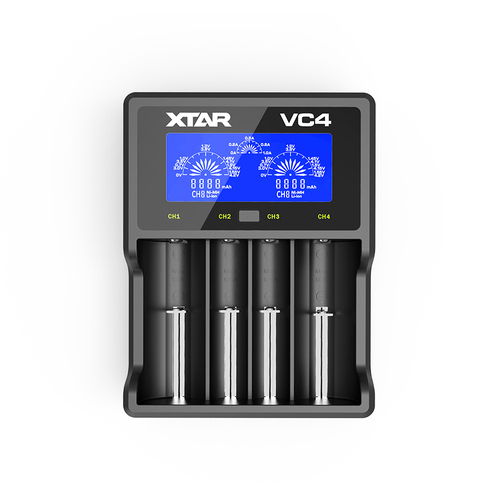 |
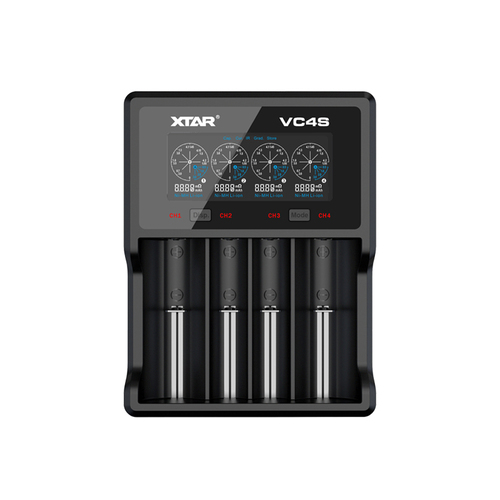 |
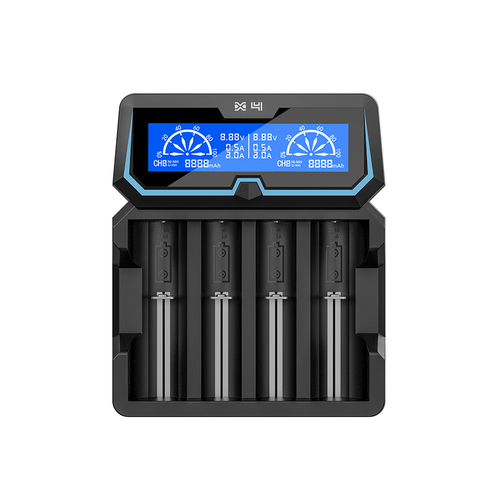 |
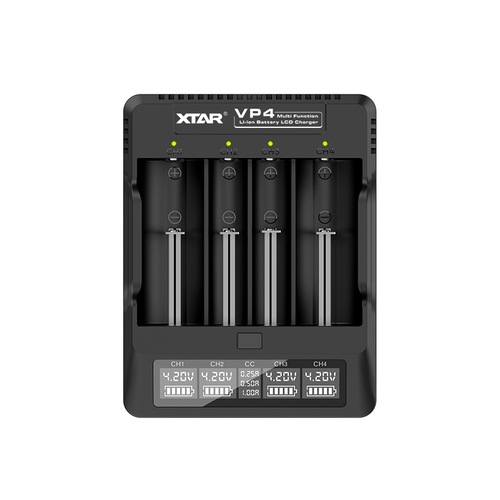 |
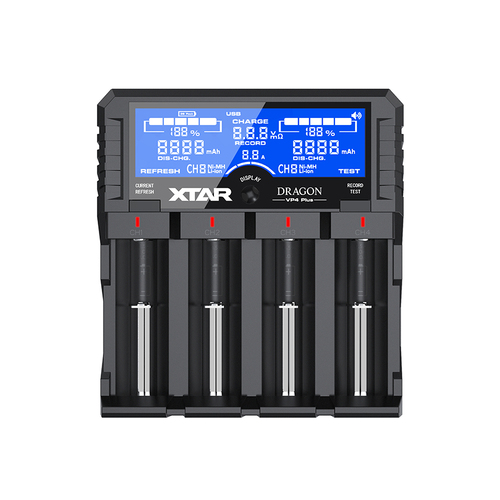 |
|
|---|---|---|---|---|---|---|
| VC4 | VC4S | X4 | VP4 | VP4 PLUS | ||
| Price on Amazon | $17.99 | $27.99 | N/A | N/A | $77.50 | |
| Battery Type | 1.2V | Yes | Yes | Yes | No | Yes |
| 3.6/3.7V | Yes | Yes | Yes | Yes | Yes | |
| Input Power | 5V 2.1A Micro USB port |
5V 2.1A / QC3.0 Micro USB port |
AC 100-240V 50/60Hz 0.8A DC 5V 2.1A |
DC 12V 1A | DC 12V 3A | |
| Max Charging Current | 1A | 3A | 2A | 1A | 2A | |
| How To Select Current | Automatically | Automatically | Automatically | Control by yourself | Control by yourself | |
| IR Test | No | Yes | No | No | Yes | |
| Capacity Test/Analysis | No | Yes | No | No | Yes | |
| Storage Mode | No | Yes | No | No | No | |
| USB Output | No | No | Yes | No | Yes | |
| LCD Display | * Battery Type * Charged Volume * Charging Current * Charging Voltage |
* Battery Type * Charged Volume * Charging Current * Charging Voltage * Internal Resistance |
*Battery Type *Charged Volume *Charging Current *Charging Voltage *Charged Power Percentage |
*Charged Volume *Charging Current *Charging Voltage |
*Battery Type *Charged Volume *Charging Current *Charging Voltage *Internal Resistance *Charged Power Percentage |
|
From the above chart I believe you’ve already know the parameter difference. Now, let’s compare the products one by one and see the difference in details.
1. XTAR VC4 Vs. X4
About the VC4 and X4 (not the new extended version), the main difference focus on the input power, charging current and output function.
The XTAR VC4 uses a micro USB input port with DC 5V 2.1A power. While the X4 charger has dual input ports – the classic AC port and Micro USB port.
Both the VC4 and X4 can charge 1.2V NiMH/NiCD and 3.6/3.7V Li-ion batteries, but the VC4 provides 1A x 2 and 0.5A x 4 charging current, and the X4 supports 2A x 2, 1A x 4 and 0.5A x 4 charging current.
In addition, the X4 also has USB output function with 5V 1A power, which can be used as a portable power bank for your emergency needs.
2. XTAR VC4 Vs. VP4
Compared with the VP4, the VC4 charger has much more important advantages. The VP4 only charge Li-ion batteries while the VC4 supports not only 3.6/3.7V Li-ion batteries but also 1.2V NiMH and NiCD batteries. Both of their charging current can reach maximum 1A, but the VC4 uses 5V 2.1A Micro USB input power instead of the DC 12V 1A of VP4 charger.
The charging current will be automatically selected by the VC4, but it can be controlled by yourselves in the VP4 charger. Some users may want to manually select the charging current to prelong battery lifespan. But don’t worry, the smart VC4 charger will detect your battery status and intelligently choose the best charging solution.
For the real charging status display, the VC4 can tell you more information, like battery type and internal resistance, besides the charging current, charging voltage and charged volume. Most of you want to know the internal resistance of your batteries, right?
If you like the VP4, we recommend you to buy its upgrade version XTAR VP4C.
3. XTAR VC4 Vs. VP4 PLUS
If you compare the VC4 with the VP4 PLUS, you will find there is huge difference between them. Just like the iPhone 6 and iPhone 12. The VP4 PLUS was the flagship of XTAR chargers. It can charge both 3.6/3.7V Li-ion and 1.2V NiMH/NiCD batteries as well as 3S battery packs. In addtion, it has much more functions, such as IR test, real battery capacity test, USB output, NiMH memory refreshing, and battery test record. It even has a power-path management system, so when it is pluged, the external devices will be charger directly from the power.
Don’t want to cost too much? Then you can consider the VC4. It was rated as the best vaping battery charger by the Business Insider in 2020. It can charge both Li-ion and NiMH batteries, with max 1A charging current. The LCD screen displays the real charging status you want to know, such as battery type, charging current and voltage, charged volume and internal resistance. As a budget charger, it is really worthy to invest.
4. XTAR VC4S Vs. X4
The VC4S and X4 chargers are both capable of 3.6/3.7V Li-ion and 1.2V NiMH batteries. But the max charging current can only be 2A while that of VC4S can reach 3A. The VC4S is not only a battery charger but also a battery tester/analyzer. It can test the internal resistance and real capacity of your batteries, inspecting the battery performance, as well as prelong your battery lifespan with storage mode.
Actually if you want to invest a classic X4 charger, we recommend you to choose the X4 extended version. It is also has dual AC and DC input port. The more important thing is it can charge the rising popular protected 21700 batteries. Now the 21700 flashlights are the trends. A charger that can charge unprotected and protected 21700 batteries will bring you big convenience.
5. XTAR VC4S Vs. VP4
There are big difference between the VC4S and VP4 charger. The VC4S can charge both 1.2V NiMH/NiCD batteries and 3.6/3.7V Li-ion batteries, while the VP4 is only a Li-ion battery charger. Their charging currents are also different. The VC4S supports maximum 3A, while the VP4 only has 1A. In addition, the VC4S is also a battery tester and analyzer. With grade and store function, it can test your batteries’ real capacity and prelong the battery lifespan.
If you are a user who cares about the battery internal resistance, this XTAR VC4S is suitable for you. It displays IR, charging current & voltage, and charged volume on the LCD screen.
But if you want to control the charging current by yourself, you can choose the VP4C, which is the upgrade version of VP4. They have the similar features but the VP4C has better usage experience.
After read the above comparison information, did you decide which charge to buy? If yes, the next step you only need is to go to our official store. If not, you can learn more information in the XTAR charger guide.